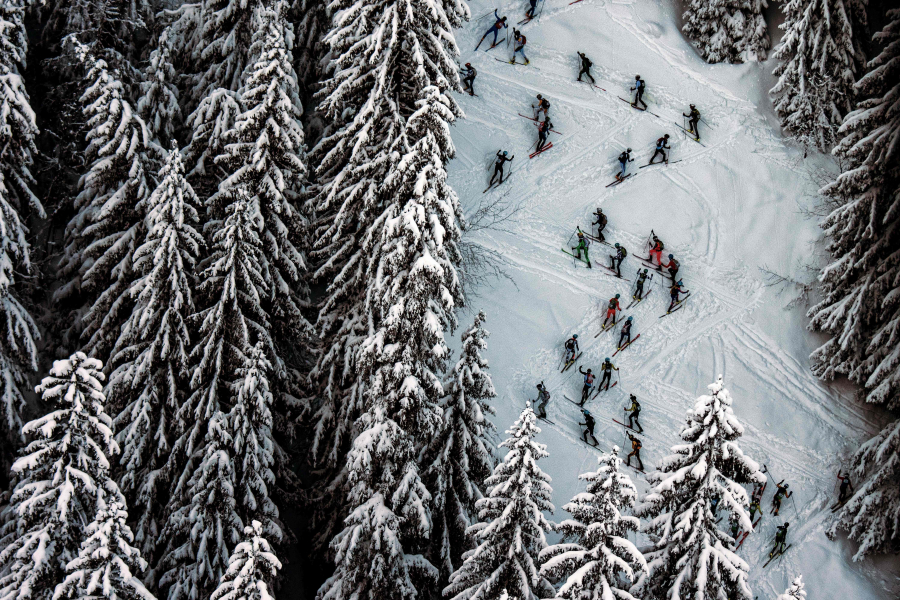CRYSTAL MOUNTAIN — With light snow falling and temperatures in the mid-20s, I shivered while waiting in line on a March morning last winter at the base of Crystal Mountain Resort. But I wasn’t queued up for first chair on the Chinook Express lift with fat powder skis strapped to my feet and thick Gore-Tex keeping me dry. I was wearing form-fitting spandex and perched atop impossibly skinny skis that I affectionately nicknamed “the toothpicks.” Instead of waiting for a ride up the chairlift, my quads were coiled to spring into action once the race director gave the green light for my wave of racers to take off uphill.
While that late winter Sunday was a perfect day for cruising around the resort, I and 50-odd others were signed up to compete in the season’s final SnowGoat Skimo Race. We climbed from the bottom to the top of Crystal, including a steep section where we affixed our skis to our backpacks and hiked up like mountaineers. Up on a ridge, we ripped our climbing skins off, stuffed them into pockets on our race suits and zoomed back down as fast as we could without wiping out on our lightweight gear. Then we did it all over again — for a total gain of 5,400 vertical feet.
Skimo, short for ski mountaineering, is an organized, competitive version of backcountry skiing or ski touring, the sport of human-powered travel through the mountains on skis equipped with climbing skins. In short, it’s a race to see who can go both uphill and downhill the fastest. In 2026, skimo will make its Olympic debut at the Winter Games in Milan and Cortina d’Ampezzo, Italy. You can get a taste in the Cascades sooner than that.
Ski mountaineering — climbing mountains and skiing down them — has a long history in the Cascades, as does competitive skiing, from alpine downhill races on Mount Rainier in the 1930s to ski-jumping competitions dating back to the 1910s. But the modern competitive iteration of this winter sport is still nascent in the Pacific Northwest, at least compared with its wild popularity in the European Alps, where spectators cheer at the finish line during World Cup races. The sport also has a strong presence in the Rockies, where a racing circuit keeps skimo athletes busy throughout the winter.
Momentum is slowly building, however, as the enthusiastic race director behind SnowGoat builds up an annual series and homegrown athletes begin to compete on larger stages, all while local backcountry skiers and splitboarders increasingly relish the opportunity to push themselves in a controlled setting like a ski area that presents fewer safety hazards than backcountry terrain.
The race director is Tacoma resident Richard Kresser, a 36-year-old firefighter who manages trail running and mountain biking races as a summer job. No stranger to self-inflicted suffering in the mountains, in 2018 he concocted “Dick’s RASH,” a weeklong adventure to solo summit and circumnavigate Mount Rainier, Mount Adams, Mount St. Helens and Mount Hood.
The skimo bug bit Kresser in 2016 when he competed in the Mountaineers’ Patrol Race from Snoqualmie Pass to Meany Lodge, a 1930s-era race that local ski historian Lowell Skoog resurrected in 2014. “I was blown away by that side of the sport,” Kresser said. As a regular in trail running races who had recently taken up ski touring, he saw a marriage of his new sport with his old competitive flame — and potential to spark others’ outdoor connections. “Skiing is a very intimidating sport and trail running races were how I met my best running partners.”
Kresser’s aspiration conveniently coincided with the Northwest Avalanche Center’s desire to hand off Vertfest, an annual backcountry ski festival at Alpental ski area that included a skimo race, to a dedicated race company. Thus, SnowGoat Skimo was born in the 2018-19 winter and will kick off its fourth season on Feb. 5 at Loup Loup ski area near Twisp in partnership with local host Cascade Endurance.
Vertfest will take place March 5 and the season will wrap at Crystal on April 3. (Oregon ski areas host three skimo races in February.) All of SnowGoat’s races are spectator-friendly at the finish line or along the course if you are out skiing or riding for the day. Upward of 15 volunteers with ski experience are needed as gatekeepers, and eight more at the base area who don’t need to know how to ski.
At a SnowGoat Skimo race, you’re likely to see hardcore racers at the front of the pack on the lightest gear imaginable while more casual competitors shuffle along on heavier equipment or even lighten the mood with a festive costume.
“We are trying to make room for everyone at the race,” Kresser said.
The fastest finishers can zip up and down Crystal twice in about two hours. Christina Volken, 26, routinely won the women’s division at SnowGoat’s first handful of races. She was raised in North Bend as the daughter of famed local mountain guide Martin Volken, which exposed her not just to Cascadian ski culture but also the skimo scene of Volken’s native Swiss Alps.
“Skimo was always in my consciousness as a serious sport that people dedicate their lives to,” she said. Back home, Christina Volken remembers checking in racers and staffing the gates as a 10-year-old at Vertfest, the oldest skimo race west of the Rockies.



